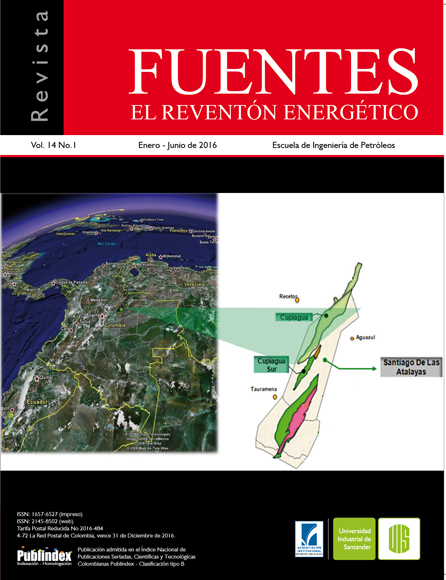A phenomenological model for scaling at reservoir level the impact over oil production due to formation damage by fines migration

Published 2016-06-24
Keywords
- Formation Damage,
- Fines Migration,
- Phenomenological Model,
- Clay Swelling,
- Critical Rate
- Cupiagua ...More
How to Cite
Abstract
The objective of the article consists in proposing and solving a model of the phenomenological bases that allows characterize, quantify and predict the formation damage due fines migration and swelling clays at reservoir level from the linear mathematical methodological scheme Civan [1]. The process of understanding the phenomenon of particles on a porous medium has been for the most cases approach from the laboratory perspective, measuring the critical rates of the formation plugs and based on this it’s had been generated a mathematical model for the simulation of the particle phenomenon by laboratory conditions. It’s construct, it’s propose, it’s applied and it’s validate a methodology for transcending and scale to the reservoir scale the results of the formation damage by the flow of fines observed in the laboratory. The generated methodology is base in performing multi-rate coreflooding tests, solve and characterize the damage by particles flow in the plug in function of velocity in the linear model of Civan, construct and determine the model for estimate the profiles of damages in function of the radius, validate the scheme with field data for estimate the impact of damage and the critical radius of the producing well. At the present time more than 50% of the oil fields operate by Ecopetrol display formation damage by particle process, the quantity of the petroleum that it stop producing by this phenomenon is estimated in the thousands of barrels, with this kind of approximation it’s can be design and optimize the treatment require for mitigate the damage and recover a significate percentage of the barrels left out of production. In this project it’s show the entire process using data from the formation Barco of Cupiagua field, the scaling results indicate drops of permeability of 65% by this type of amage, damage radius between 1.9 and 4.4 ft and skin value by fines between 1.9 and 3.4. This process allows to generate the designs of the stimulating treatment for this field.
Downloads
References
2. Muecke, T. “Formation Fines and Factors Controlling Their Movement in Porous Media”. SPE 7007. 1976.
3. Gruesbeck, C. and Collins, R. E. “Entrainment and Deposition of Fine Particles in Porous Media”. SPE 8430. 1982.
4. Khilar, K.C. and Floger, H.S. “Water Sensitivity of Sandstone”. SPE 10103. 1983.
5. Sharma, M.M. and Yortsos, Y.C. “Permeability Impairment due to Migration in Sandstone”. SPE 14819. 1986.
6. Wojtanowicz, A.K. Kroliv, Z. and Langlinis, L.P. “A study on the effect of Pore Bloking Mechanisms on Formation damage”. SPE 16233. 1987.
7. Ohen, H.A. and Civan, F. “Predicting Skin Effects Due to Formation Damage by Fines Migration”. SPE 21675. 1991.
8. Ohen, H.A. and Civan, F. “Simulation of Formation Damage in Petroleum Reservoirs”. SPE 19420. 1993.
9. Xinghui, L. and Civan, F. “Formation Damage and Skin Factor Due to Filter Cake Formation and Fines Migration in the Near-Wellbore Region”. SPE 27364. 1994.
10. Xinghui, L. and Civan, F. “Formation Damage by Fines Migration Including Effects of Filter Cake, Pore Compressibility, and Non-Darcy Flow - A Modeling Approach to Scaling From Core to Field”. SPE 28980. 1995.
11. Binsha, J. Fan, T. and Wang, X. “A novel 3D FieldScale Reservoir Numerical Simulator for predicting the fines Migration and production performance”. SPE 99799. 2006.
12. Civan, F. “Non- isothermal permeability impairment by fines migration and deposition in porous media including dispersive transport”. Transp Porous Med vol 85:233–258. 2010.
13. Bedrikovetsky, P. Zeinijahromi, A. “Particle Detachment Under Velocity Alternation During Suspension Transport in Porous Media”. Transp Porous Med vol 91:173–197. 2012.
14. Ruiz, M. Barreto, D. Contreras, D. Zabala, R. “Construcción de un modelo para caracterizar daño por procesos de partículas en formaciones productoras”. Energética 32. 2004. ISSN 0120- 9833.
15. Zabala, R. D. Barreto, D. L y Contreras, D. I. “Una Metodología de Estimación de las Constantes Fenomenológicas del Modelo de Civan por el Método de Marquardt – Levenberg”. Informe Trabajo Dirigido de Grado-Pregrado, Universidad Nacional de Colombia, Agosto de 2004.
16. Restrepo, A. Duarte, J. Sanchez, Y. “A MultiParameter Methodology for Skin Factor Characterization: Applying Basic Statistics to Formation Damage Theory”. Paper SPE 107674-MS presented at the SPE European Formation Damage Conference, Scheveningen, The Netherlands, 30 May- 1 June 2007.